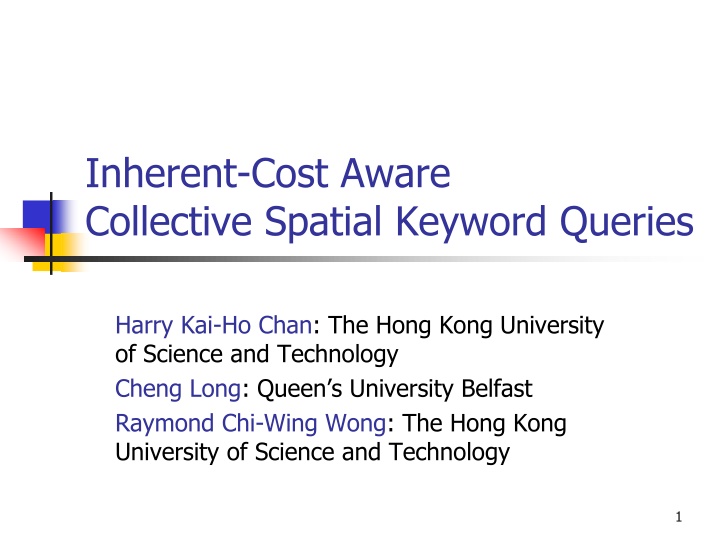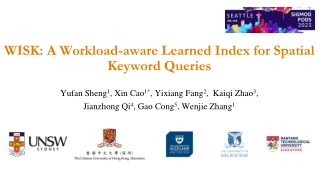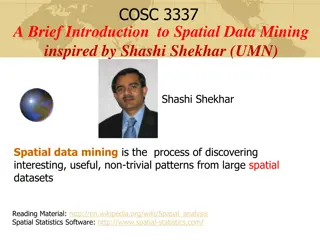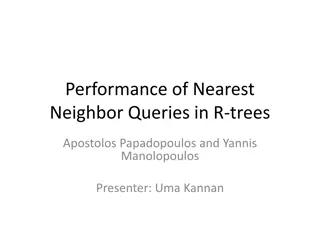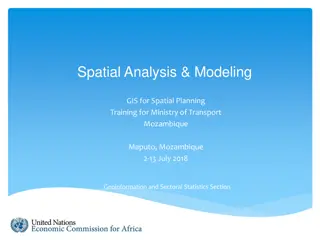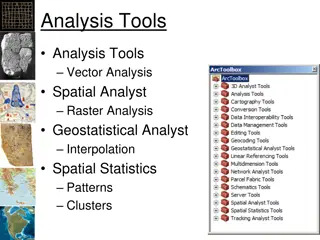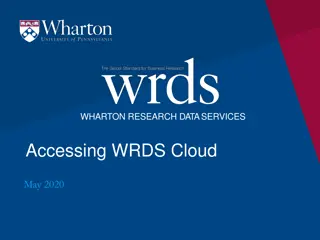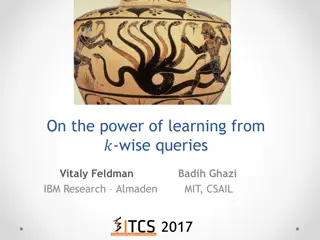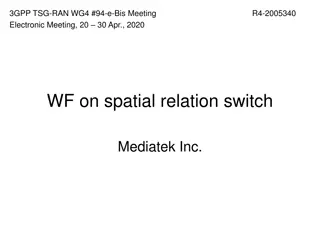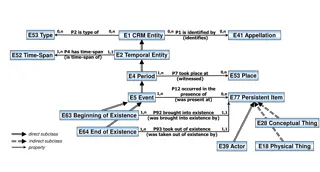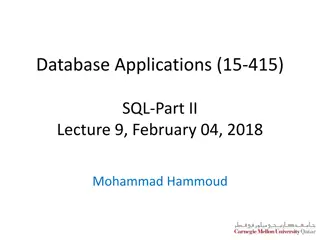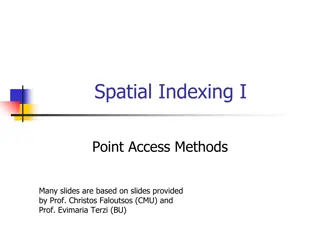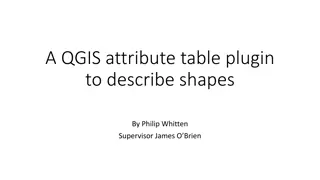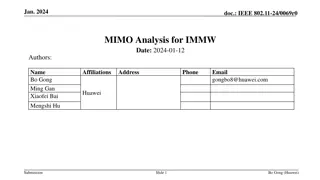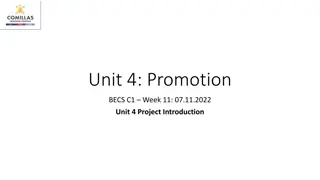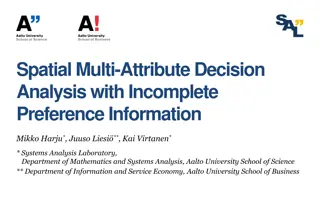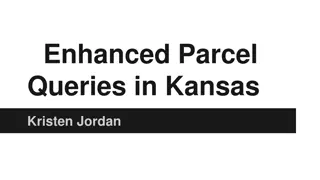Collective Spatial Keyword Queries with Inherent Cost Awareness
Spatial-textual data involving points of interest like restaurants and hotels, with a focus on Collective Spatial Keywords Queries (CoSKQ) and the introduction of a new cost function that considers both spatial distances and inherent costs of objects.
Download Presentation

Please find below an Image/Link to download the presentation.
The content on the website is provided AS IS for your information and personal use only. It may not be sold, licensed, or shared on other websites without obtaining consent from the author.If you encounter any issues during the download, it is possible that the publisher has removed the file from their server.
You are allowed to download the files provided on this website for personal or commercial use, subject to the condition that they are used lawfully. All files are the property of their respective owners.
The content on the website is provided AS IS for your information and personal use only. It may not be sold, licensed, or shared on other websites without obtaining consent from the author.
E N D
Presentation Transcript
Inherent-Cost Aware Collective Spatial Keyword Queries Harry Kai-Ho Chan: The Hong Kong University of Science and Technology Cheng Long: Queen s University Belfast Raymond Chi-Wing Wong: The Hong Kong University of Science and Technology 1
Outline 1. Introduction 2. Contribution 3. Problem Definition 4. Algorithms 5. Experimental Results 6. Conclusion 2
1. Introduction Spatial-textual data Spatial points of interest Restaurants, hotels, tourist attractions,... Geo-tagged web objects Photos with both tags and geo-locations at Flickr, check-in information on places in FourSquare,... 3
Cao et al. SIGMOD 2011 Long et al. SIGMOD 2013 Cao et al. TODS 2015 1. Introduction Collective Spatial Keywords Queries (CoSKQ) Given a query with a location and a set of keywords It finds a set S of objects that Covers the keywords collectively Has the smallest cost Application A tourist wants to find several POIs for sightseeing, shopping and dining, and the POIs are close to him A manager wants to set up a project consortium of partners 4
1. Introduction Collective Spatial Keywords Queries (CoSKQ) k3 k1 k1, k3 k2, k3 q k3 k2 k3 k1, k2, k3 5
1. Introduction Collective Spatial Keywords Queries (CoSKQ) k3 k1 k1, k3 k2, k3 q k3 k2 k3 k1, k2, k3 6
1. Introduction Collective Spatial Keywords Queries (CoSKQ) Cost functions proposed by previous studies ???????,??????????,??????????, ???????, ?????????? Suitable in applications where the cost of a set of objects could be captured well by the spatial distances among the objects and the query only. However, we observe that in some applications, each object has an inherent cost (e.g., workers have monetary costs), which are not captured by any of these existing cost functions. 7
1. Introduction Collective Spatial Keywords Queries (CoSKQ) New Cost Function ?????????????? Captures both the spatial distances between the objects and the query, and the inherent costs of the objects Application A manager wants to find a group of workers. Each worker is associated with some monetary cost A tourist wants to visit some POIs (e.g., museums and parks). Each POI is associated with an admission fee 8
1. Introduction Collective Spatial Keywords Queries (CoSKQ) 3 k3 4 4 k1 3 k1, k3 k2, k3 q k3 5 6 k2 8 k3 2 k1, k2, k3 9
2. Contributions We propose a new cost function ??????????????, which captures both the spatial distances between the objects and the query, and the inherent costs of the objects, for the CoSKQ problem. We prove the NP-hardness of CoSKQ problem with ??????????????. We propose an exact algorithm MaxDotSize-E and an approximate algorithm MaxDotSize-A with an approximation guarantee. 10
3. Problem Definition Notations ? ? ? = (?,?) an object q= (?,?) a query d(o,q) Euclidean distance between o and q a location a set of keywords 11
3. Problem Definition CoSKQ: Find a set S of objects s.t. S covers the set of query keywords the cost of S, denoted by cost(S), is minimized Maximum dot size function ? ?? ?,? ? ??.???? cos???????????? = max Captures the inherent costs of the objects Captures the spatial distances between the objects and the query 12
3. Problem Definition For simplicity, we assume that each object has a unit cost Overall inherent cost of a set of objects is equivalent to the size of this set cos???????????? = max ? ?? ?,? |?| Both MaxDotSize-E and MaxDotSize-A could also be applied to the general case with arbitrary costs 13
4. Algorithm MaxDotSize-E Some terminologies A set is feasible if it covers all query keywords Query distance owner of a set S: the object ? ? that is most far away from the query location An observation The query distance owner determines the spatial distance component in the cost function o q cos???????????? = max ? ?? ?,? |?| 14
4. Algorithm MaxDotSize-E Algorithm Maintain a best-known feasible set S For each query distance owner o Find the best feasible set S Update S by S if cost(S ) < cost(S) Return S Speedup strategies Constraints for objects to be a query distance owner Prune objects when enumerating best feasible set 15
4. Algorithm MaxDotSize-E Pruning: Not each object o is necessary to be considered as a query distance owner Distance constraint Lower bound of d(o,q) ? ?,? ???= max Upper bound of d(o,q) ? ?,? ???= ???? ? ? ?(?)?(?,?) 16
4. Algorithm MaxDotSize-E Pruning: Not each object o is necessary to be considered as a query distance owner Keyword constraint For an object o with d(o,q) > dLB , Lower bound of number of query keywords covered |o.? ?.?| 2 17
4. Algorithm MaxDotSize-E Pruning: Not each object o is necessary to be considered as a query distance owner An object o can be pruned if any of the following two conditions is not satisfied: 1. ??? ? ?,? ??? 2. ( d(o,q) = dLB ) or ( d(o,q) > dLB and |o.? ?.?| 2 ) 18
4. Algorithm MaxDotSize-E Finding the best feasible set S with the query distance owner o Exhaustive search for S in D(q,d(o,q)) Pruning: Not each object o is necessary to be enumerated o ?.? = ?1,?2,?3,?4 ?.? = ?1,?2 ?1.? = ?3,?4 ?2.? = ?3 o1 q o2 o2 is dominated by o1 D(q,d(o,q)) 19
4. Algorithm MaxDotSize-A Algorithm Maintain a best-known feasible set S For each query distance owner o Find the best feasible set S Update S by S if cost(S ) < cost(S) Return S Find a feasible set S (which may not be the best but easier to find) 20
4. Algorithm MaxDotSize-A Find a feasible set S Initialize S to {o} While there is an uncovered query keyword ? An object in D(q,d(o,q)) which has the greatest number of uncovered keywords S ? {? } Return S o q D(q,d(o,q)) 21
4. Algorithm MaxDotSize-A Approximation bound: ln|?.?|-approximation Idea There exists an iteration that MaxDotSize-A processes the query distance owner of the optimal solution The greedy process construct S by selecting objects in D(q,d(o,q)) Time complexity: ?(?1 ( ? ? ?.? + ?2|? |)) 22
5. Experiment Datasets: Hotel, GN and Web (same as the existing studies) Algorithms Cao-E, MaxDotSize-E Cao-A1, Cao-A2, Cao-A3, Long-A, MaxDotSize-A Factors No. of query keywords, Average No. of keywords contained by an object, No. of objects in the dataset Measurements Running time and approximation ratio 23
5. Experiment Dataset: Hotel Factor: Number of query keywords 24
5. Experiment Object Inherent Cost We assign each object an integer inherent cost in the range [1,5] randomly 25
6. Conclusion Studied Collective Spatial Keyword Query problem Proposed a new cost function Captures both spatial distances and object inherent cost Developed exact and approximate algorithms Extensive experiments 26
Q & A 27
